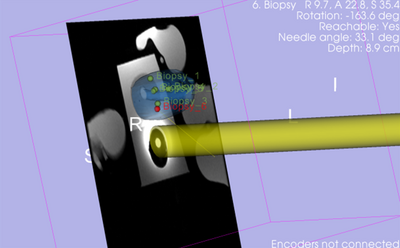DBP:Prostate Cancer
Prostate Cancer Solutions

|
|
Segmentation and Registration Tools for Robotic Prostate Interventions
Dr. Fichtinger and colleagues from Queens University are investigating methods to improve prostate cancer diagnosis and therapy through the use of machine robotics. Before collaborating with NA-MIC, Dr. Fichtinger had been developing a custom software application to integrate various segmentation, registration, organ tracking, and robotic control algorithms into a clinically usable system for treating prostate cancer. The development team had encountered several systemic limitations. First, significant effort was required to implement basic functionalities, such as image visualization, graphical user interface (GUI), and data management. Second, with each new integration of algorithms and features, the overall complexity of the software kept increasing, making it difficult for users to learn and for developers to maintain and enhance the system. Additionally, it had proved difficult to find collaborators with the appropriate technical capability and the willingness to learn a customized software and assist them to develop new methods within this framework. Through its collaboration with NA-MIC, this DBP has been able to build an application for their cutting-edge robotics technology. By leveraging existing NA-MIC tools, they have avoided duplicative work to implement basic functionalities and have developed a wide range of segmentation and registration algorithms. Moreover, as a consequence of the modular architecture of 3D Slicer, they have been able to integrate all of their previous algorithms into one framework and combine them with functionalities already implemented by others. As a result, this DBP now has a single software with manageable complexity that works with multiple generations of the prostate robot. As a consequence of this successful collaboration, Dr. Fichtinger and colleagues have started to use 3D Slicer as a basis for several new computer-aided intervention software applications, including an augmented reality image overlay system for needle insertion (Perk Station), a test bench for real-time monitoring of tissue ablation, and a gynecologic radiotherapy system. The open source robot control and treatment planning platform developed under NA-MIC has empowered this DBP to participate in several major international and national alliances in the USA, Canada, and Austria.